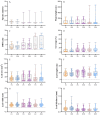Evaluating the Impact of Near-Natural Restoration Strategies on the Ecological Restoration of Landslide-Affected Areas Across Different Time Periods
- PMID: 40805680
- PMCID: PMC12348911
- DOI: 10.3390/plants14152331
Evaluating the Impact of Near-Natural Restoration Strategies on the Ecological Restoration of Landslide-Affected Areas Across Different Time Periods
Abstract
Landslides are a common geological hazard in mountainous areas, causing significant damage to ecosystems and production activities. Near-natural ecological restoration is considered an effective strategy for post-landslide recovery. To investigate the impact of near-natural restoration strategies on the recovery of plant communities and soil in landslide-affected areas, we selected landslide plots in Lantian County at 1, 6, and 11 years post-landslide as study sites, surveyed plots undergoing near-natural restoration and adjacent undisturbed control plots (CK), and collected and analyzed data on plant communities and soil properties. The results indicate that vegetation succession followed a path from "human intervention to natural competition": species richness peaked at 1 year post-landslide (Dm = 4.2). By 11 years, dominant species prevailed, with tree species decreasing to 4.1 ± 0.3, while herbaceous diversity increased by 200% (from 4 to 12 species). Soil recovery showed significant temporal effects: total nitrogen (TN) and dehydrogenase activity (DHA) exhibited the greatest increases after 1 year post-landslide (132% and 232%, respectively), and by 11 years, the available nitrogen (AN) in restored plots recovered to 98% of the CK levels. Correlations between plant and soil characteristics strengthened over time: at 1 year, only 6-9 pairs showed significant correlations (p < 0.05), increasing to 21-23 pairs at 11 years. Near-natural restoration drives system recovery through the "selection of native species via competition and activation of microbial functional groups". The 6-11-year period post-landslide is a critical window for structural optimization, and we recommend phased dynamic regulation to balance biodiversity and ecological functions.
Keywords: ecological succession; landslide; restoration strategies; soil properties; vegetation characteristics.
Conflict of interest statement
The authors declare no conflicts of interest.
Figures






References
-
- Restrepo C., Vitousek P., Neville P. Landslides Significantly Alter Land Cover and the Distribution of Biomass: An Example from the Ninole Ridges of Hawai’i. Plant Ecol. 2003;166:131–143. doi: 10.1023/A:1023225419111. - DOI
-
- Sidle R.C., Bogaard T.A. Dynamic Earth System and Ecological Controls of Rainfall-Initiated Landslides. Earth-Sci. Rev. 2016;159:275–291. doi: 10.1016/j.earscirev.2016.05.013. - DOI
-
- Kirschbaum D., Stanley T., Zhou Y. Spatial and Temporal Analysis of a Global Landslide Catalog. Geomorphology. 2015;249:4–15. doi: 10.1016/j.geomorph.2015.03.016. - DOI
-
- Lopes L.F., Oliveira S.C., Neto C., Zezere J.L. Vegetation Evolution by Ecological Succession as a Potential Bioindicator of Landslides Relative Age in Southwestern Mediterranean Region. Nat. Hazards. 2020;103:599–622. doi: 10.1007/s11069-020-04002-y. - DOI
-
- Greenwood J.R., Norris J.E., Wint J. Assessing the Contribution of Vegetation to Slope Stability. Proc. Inst. Civ. Eng.—Geotech. Eng. 2004;157:199–207. doi: 10.1680/geng.2004.157.4.199. - DOI
Grants and funding
LinkOut - more resources
Full Text Sources
Research Materials

